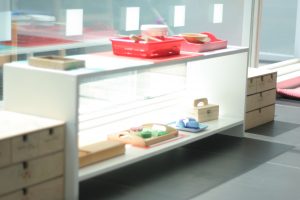Today, let’s have a look at art the Montessori way. What is the best way for you to encourage the inner artist in your child? Here are my 5 favourite tips for creating art with young children.
My top 5 art and craft tips
1. Provide an accessible art and craft area in your home
The child then has everything they need on hand, requiring little or no assistance from an adult. In our house we have set out on the bookshelves at child height:
– a stack of paper in various colours, sizes and textures
– a set of drawers: with crayons in one drawer, pencils in another, markers in another
– a tray with glue sticks, craft glue, scissors, ruler, sticky tape, hole punch, stapler
– box of randomly collected bits for craft (including bottle tops, glitter, crepe paper etc)
– due to limited space in our flat, we don’t have an easel or other painting area. But paintbrushes and paints are on hand whenever we can clear some space on the dining table to paint
When your child is young, the area will be a lot simpler — perhaps one or two crayons and some paper – and will grow with your child.
2. Focus on the process, not the product
Materials are offered for the child’s artistic expression, not the product. Better to describe (such as, looking carefully and commenting, “You used red and orange paint” or “You made lots of circles today”) rather than value judgments (such as, “It is beautiful” or “What is it?” or “Goedzo”).
3. Provide good quality art materials
I recommend to buy fewer good quality art materials that give a nice texture and colour than many cheaper materials that aren’t as beautiful. My favourite pencils are Stabilo Woody 3-in-1. They give a beautiful strong colour and can wash off a smooth table. They aren’t meant for eating so do take care with young children.
4. Show by example
When presenting materials to your child, it is often better to draw squiggles or loose lines than a picture. If you show them a perfect looking flower and they can only scribble, some children will not try at all. And whilst it is nice and highly recommended to create together, side by side, better to take your own piece of paper than draw on your child’s paper. We do not know the child’s intention for the work. Think of it as a fellow student’s picture in an art class. Would you draw a little love heart on their self-portrait? And the best example of all: hang beautiful artwork on the walls of your house and at child height too, for your child to appreciate.
5. Find a way to manage art in your household
Some ideas:
– have a place where you put useable scraps of paper
– use office “in-trays” for each child to put any finished work or work they want to come back to
– once the trays get full, get your child to choose some of their favourites and let them glue them in a ‘plakboek’ (These scrapbooks — available from stationery shops and places like Hema — are reasonably priced and good quality)
– send some to grandparents
– recycle them as unique wrapping paper
– a nice way to keep a record of artwork that is too bulky to keep is to photograph it!
The best sign of a successful art area is one that is being well used. If yours isn’t, have another look at these tips and see if you can make some changes to encourage your child to enjoy exploring the art area in your home.
Dr Montessori was asked if the Montessori environment produced good artists. Her response was, “I don’t know if we produce good artists. But we do produce a child with an eye that sees, a soul that feels, and a hand that obeys.” I think that is a good basis for any artist!
Pop over to our Facebook page and post photos of your art area, or share your favourite art tips and projects. And feel free to post any questions that you have.
And most of all enjoy yourselves!
